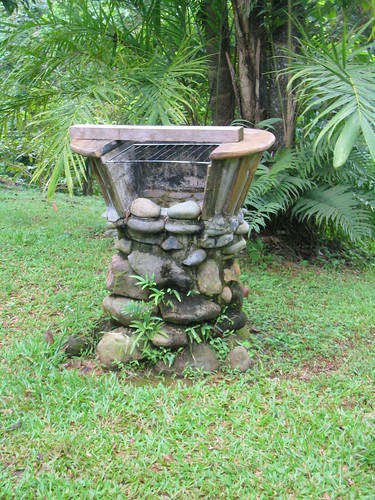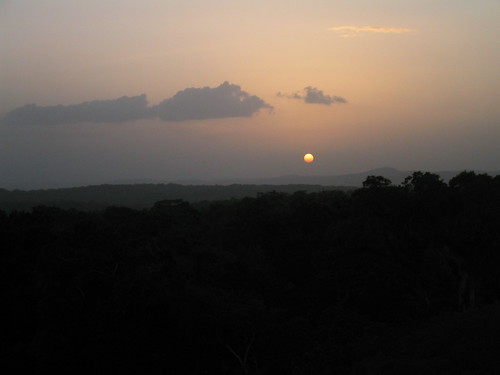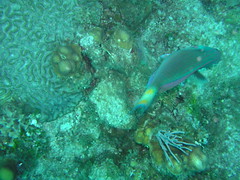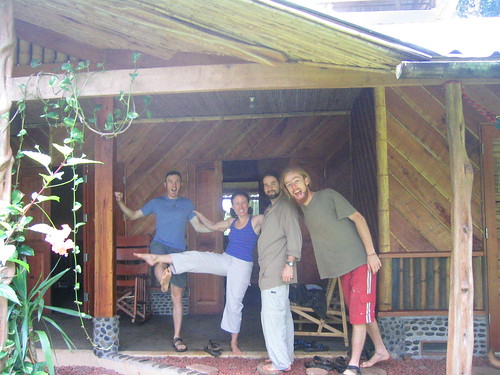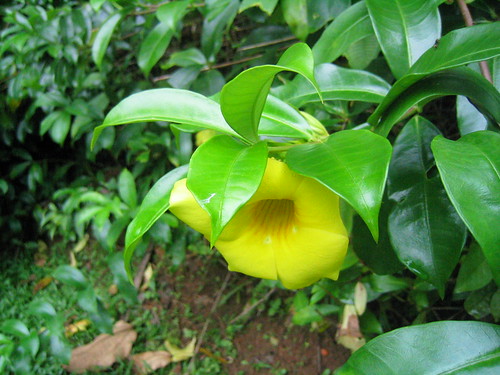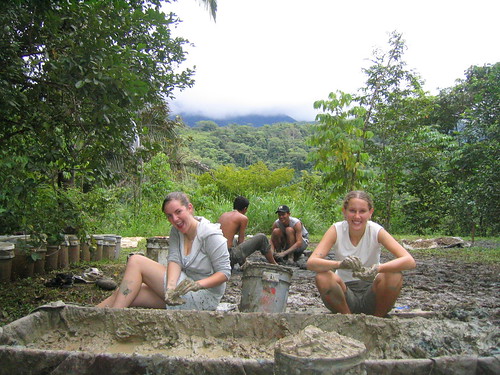
We then rolled them into more manageably sized bricks and carried them over to the house. From there we slapped the bricks onto the two foot thick wall and then used a 5" long stick, called a cobbers thumb, to work them into the existing wall. The more we poke into our wet mud bricks in the more the straw is sewed together with the rest of the wall.
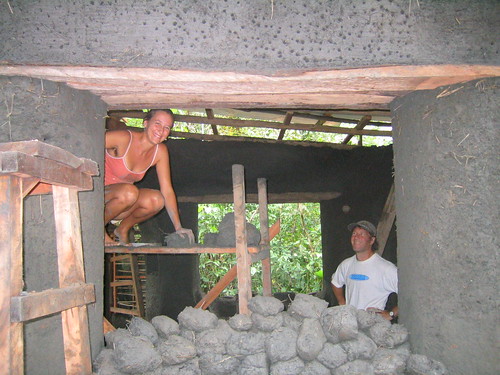
Once it's done it'll be strong as a rock, so it can easily support a roof. That's done by making a deadman, a T made out of two pieces of lumber linked together by a piece of rebar and a ton of nails sticking out from every direction. It looks like some cruel medieval weapon but when it's buried in the cob it gives a very secure patch of wood to attach a rafter too. After leaving it for a couple days to dry we used a machete to trim the walls. The inside has a 5 degree slope and the outside of the wall is plumb. The walls are solid after a few days and after a couple months it will be one large monolithic wall that'd take a bulldozer to move.
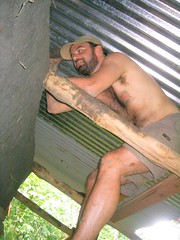
Waddle and Daub is a related technique to Cob but in this case you add cow manure into the mix and build it around a framework. It makes the cob bricks smoother, stickier, and far easier to shape which is great for adding in little sculptural details to a wall. Before this month I never thought I would say "I miss the texture of cow manure" but alas it has come to pass. It also is a handy mix to use when you don´t want to build a wall with the full 2 foot thickness by just using it to glom onto an internal frame. Tim and Robins had a traditional Cob wall built around their bedroom, but for each of the other walls in their home they had a 6" wide waddle and daub wall built around a bamboo lattice work. And now, to answer the questions you all are anxiously asking. Yes, it does smell a bit while you are working with it but it will smell less and less as it dries. And Tim and Robins final step will be to coat the whole house with a brightly colored lime plaster which will forever lock away the odor.
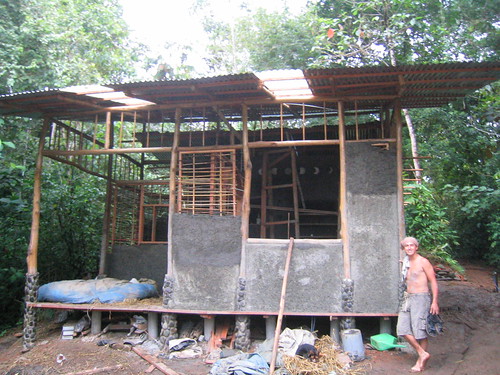
Cob can be really artistic too in an organic and smooth sort of way. Straight lines are optional, and in fact quite challenging, so it's simple to make smooth organic curves. It's easy work to carve in nooks, shelfs, and by adding a simple wooden frame we made windows and doors. Like, for example Dan and Andy are showing off how we recycled some old gallon tin cans into imbedded moon shaped window vents that go all the way through. Also, check out the candle sconce that Tyler shaped into the same wall.
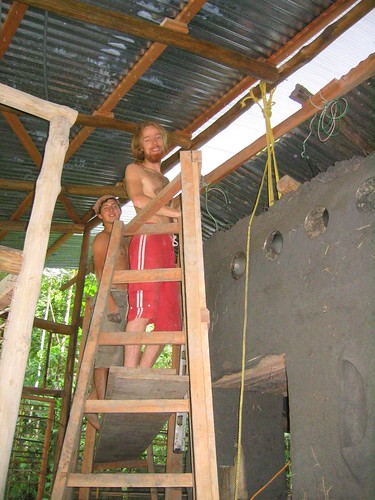
A budding sculptor can shape figures or add stones in the cob that instantly become part of the wall. By adding a coat of limestone putty in the end with natural ochre tints on the outside it's easy to get a variety of colors.
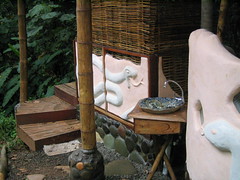
Cob is a great building material for many reasons. First of all, if done right it's about as sustainable as could be. The clay comes from a nearby farmers land, the straw was growing wild on the side of a hill and the sand came from a nearby river bank. Some fortunate cobbers discover the perfect blend of clay and sand on the very land they're building on but here it will only cost the earth a few gallons of gas to truck over everything Tim and Robin will need for their home. The wall itself could last centuries, as testified by the ancient adobe homes of Native Americans still standing in the American southwest, but in this climate if this home is abandoned for a few decades it'll eventually melt indistinguishably into the earth. While used, however, it's still profoundly sustainable. Because there is so much mass to it the house itself acts like a big heat battery. At high noon on a hot, hot, Costa Rican summer day the walls will keep the house cool because they cooled all night. On a slightly chilly night, conversly, the building will slowly let out the heat it stored that afternoon. It works great in a huge variety of climates. It's ideal for someplace like a dessert with cold nights and hot days but even if it was built somewhere with a cold winter the occupants would find this moderating effect takes a bite out of a brutally cold week. It makes a woodburning stove very viable because it absorbs the heat while a fire is too burning bright and hot and holds that heat if the owner lets the fire go out in the middle of night.
Cob isn't limited to walls, its simple to make any durable structure like a bench:
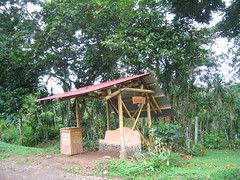
a shower
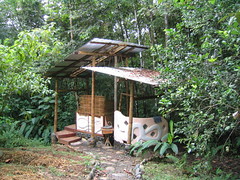
or even an oven
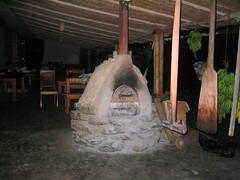
Not only is it inexpensive, attractive, healthy for the earth and highly efficient but Cob is simple to work with. The basics could be taught to any one, particularly someone with a childs heart who enjoys playing in the mud. Mistakes are remedied by either slapping on an extra layer, or scraping one off. One could justifiably ask why humans build with anything else. The reality of it is, while easy and fun it is hard work. And there is a lot of it. We were fortunate to get involved on the final couple feet of Tim and Robins house and its taken us weeks of working nearly every day to do that. It's satifying for us to finish the wall and put on the roof but I can imagine how daunting it was for an earlier crew, six months ago, to spend a couple weeks to make little more than a large mud doughnut in the shape of what would someday be a home. Tim and Robin can afford to do it here because manpower is what, by virtue of what they do, they have plenty of. People like Tyler and I, as well as this U Washington class, come here looking forward to getting dirty building something sustainable. Cob works well for big groups like ours because a lot of people can work on various jobs without too much coordination. It's ideal if one can get together a mess of friends for a messy workparty. But you'd need a lot of beer to fuel morale after the first day or two, let alone for weeks. Before long an aspiring homebuilder will find their friends don't RSVP party invites until it's for the long awaited housewarming party.
I don't really know when next Tyler and I will get to use our freshly minted cobbing skills but I think we will. It's a valuable way to build homes for people without many resources but lots of time or could simply be used to make a really distinctive backyard barbeque.
